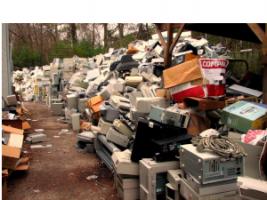What is E-Waste and Should We Care?
- < The Mystery of Building Product Specification
- > The Age of Flower Power Architecture and How It Transforms Affordable Housing, Smart Growth...
In January 2019, the World Economic Forum released a publication, A New Circular Vision for Electronics: Time for a Global Reboot. It is in support of The E-Waste Coalition, a group of seven UN entities that have joined forces to address the e-waste challenge. E-waste is one of the biggest challenges of the world economy and climate change, and its current system of production and consumption is in need of an overhaul. Each year, around 50 tonnes of e-waste are produced, of which only 20% is recycled. This causes a huge problem, while also ignoring a huge opportunity.
The problem is that e-waste is the fastest growing waste stream in the world, filling landfills and being treated in ways that release toxic materials into the environment. E-waste can be described as anything with a plug, electric cord, or battery and includes toasters, toothbrushes, computer equipment, mobile phones, stereos, LCD and Plasma TVs, solar panels, microwaves, printers, scanners, fax machines, mice, keyboards, stereos, copiers, rechargeable batteries, servers, UPS units, portable DVD players with LCD screens, ovens, and fridges. According to the World Economic Forum publication, it’s not just households causing this waste; governments and businesses contribute as well, and while E-waste may represent only 2% of solid waste streams, but it can equal up to 70% of the hazardous waste that ends up in a landfill. Some of these electronics contain lead, nickel, and mercury which, if leaked into the air, water, or soil, can harm people as well as local plants and wildlife. According to DoSomething.org, a large number of what is labeled as “e-waste” is actually whole electronic equipment or parts that are marketable for reuse or can be recycled for materials recovery; recycling 1 million laptops saves the energy equivalent to the electricity used by 3,657 U.S. homes in a year; and cell phones and other electronic items contain high amounts of precious metals like gold or silver. Americans alone dump phones containing over $60 million in gold/silver every year, and for every 1 million cell phones that are recycled, 35, 274 lbs of copper, 772 lbs of silver, 75 lbs of gold, and 33 lbs of palladium can be recovered.
How Can This Cycle End?
E-waste is a global problem as well, through global use and through shipping waste overseas and between countries. The problem exacerbates when e-waste is burned for scrap in junkyards, primarily in third-world countries, making toxicity a huge risk both for the environment and for the people burning the waste. But shipping the electronics overseas doesn’t have to be a bad option.
1. If the electronics are repaired, it can give people access to low-cost electronics
2. Repairing electronics creates a need for skilled repair people, which creates jobs in countries that often are lacking them
3. Reusing electronic parts in developing countries is usually more successful, since the market is typically more suited for older parts
4. The lives of electronics need to be extended. Recycling should happen only after the electronic has been used to its very last breath, and as a society, we need to stop thinking bigger, newer, fancier
5. More education needs to be offered on how e-waste recycling is done. It’s an expensive process already, so learning how to be efficient at and to actually do it is important. E-waste needs to be recycled separate from regular waste, and often needs to be separated categorically from each other. Also, people are afraid of their personal data on electronics they hold onto them to protect that data, not understanding that there are ways to protect their info
In the AEC and product manufacturing industry, steps can be made to eliminate waste. Even if this can’t be done as aggressively with the technology choices made, it can be done within business offices and personal choices. It can also be done while building toward the future with more smart buildings and the technology used to build these—what can be done to make them more sustainable and to extend the life of the electronics used, or minimize the need for these electronics, in order to avoid e-waste? It’s a delicate balance, but an important one.
What steps have you taken to avoid e-waste in your business?
For more information or to discuss the topic of this blog, please contact Brad Blank





